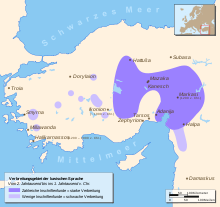- Çineköy inscription
-
 Distribution of the Luwian language, shown in purple.
Distribution of the Luwian language, shown in purple.
The Çineköy inscription is a Hieroglyphic Luwian-Phoenician bilingual, uncovered from Çineköy, Adana Province, Turkey (ancient Cilicia), dating to the 8th century BC. Originally published by Tekoglu and Lemaire (2000)[1], it was more recently the subject of a 2006 paper published in the Journal of Near Eastern Studies, in which the author, Robert Rollinger, lends support to the age-old debate of the name "Syria" being derived from "Assyria" (see Etymology of Syria).
The object on which the inscription is found is a monument belonging to Urikki, vassal king of Hiyawa (i.e. Cilicia), dating to the eighth century BC. In this monumental inscription, Urikki made reference to the relationship between his kingdom and his Assyrian overlords. The Luwian inscription reads "Sura/i" whereas the Phoenician translation reads ’ŠR or "Ashur" which, according to Rollinger (2006), "settles the problem once and for all".[2]
Contents
The Inscription
The examined section of the Luwian inscription reads:
-
- §VI And then, the/an Assyrian king (su+ra/i-wa/i-ni-sa(URBS)) and the whole Assyrian "House" (su+ra/i-wa/i-za-ha(URBS)) were made a fa[ther and a mo]ther for me,
§VII and Hiyawa and Assyria (su+ra/i-wa/i-ia-sa-ha(URBS)) were made a single “House.”
- §VI And then, the/an Assyrian king (su+ra/i-wa/i-ni-sa(URBS)) and the whole Assyrian "House" (su+ra/i-wa/i-za-ha(URBS)) were made a fa[ther and a mo]ther for me,
The corresponding Phoenician inscription reads:
-
- And the king [of Aššur and (?)]
- the whole “House” of Aššur (’ŠR) were for me a father [and a]
- mother, and the DNNYM and the Assyrians (’ŠRYM)
- were a single “House.”
See also
- Syria (etymology)
- Names of Syriac Christians
External links
- Inscription From 800 BC Shows the Origin of the Name 'Syria'
- Nytt fynd stärker samband mellan suroye-asuroye (in Swedish)
- Neue Entdeckung erhöht Verbindung zwischen Suroye und Asuroye (in German)
References
- ^ Tekoglu, R. & Lemaire, A. (2000). La bilingue royale louvito-phénicienne de Çineköy. Comptes rendus de l’Académie des inscriptions, et belleslettres, année 2000, 960-1006.
- ^ Rollinger, Robert (2006). "The terms "Assyria" and "Syria" again" (PDF). Journal of Near Eastern Studies 65 (4): 284–287. http://www.aina.org/articles/ttaasa.pdf.
Categories:- Anatolia
- Assyriology
- Luwian inscriptions
- Phoenician inscriptions
- Multilingual texts
- 8th-century BC works
-
Wikimedia Foundation. 2010.
